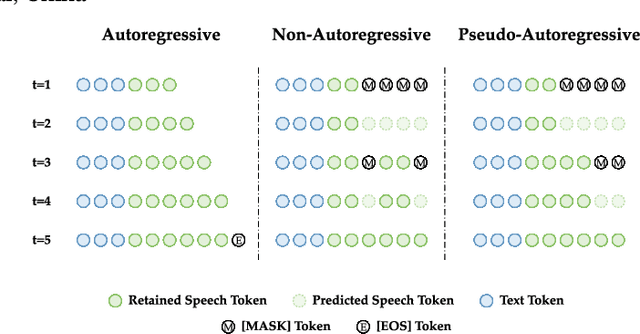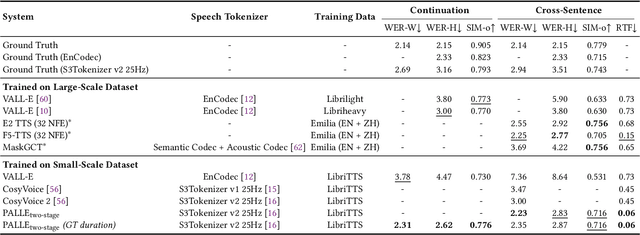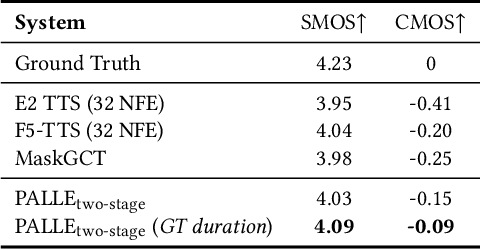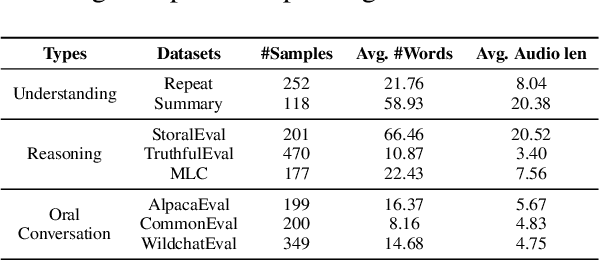Shujie Liu
Towards Responsible Evaluation for Text-to-Speech
Oct 08, 2025Abstract:Recent advances in text-to-speech (TTS) technology have enabled systems to produce human-indistinguishable speech, bringing benefits across accessibility, content creation, and human-computer interaction. However, current evaluation practices are increasingly inadequate for capturing the full range of capabilities, limitations, and societal implications. This position paper introduces the concept of Responsible Evaluation and argues that it is essential and urgent for the next phase of TTS development, structured through three progressive levels: (1) ensuring the faithful and accurate reflection of a model's true capabilities, with more robust, discriminative, and comprehensive objective and subjective scoring methodologies; (2) enabling comparability, standardization, and transferability through standardized benchmarks, transparent reporting, and transferable evaluation metrics; and (3) assessing and mitigating ethical risks associated with forgery, misuse, privacy violations, and security vulnerabilities. Through this concept, we critically examine current evaluation practices, identify systemic shortcomings, and propose actionable recommendations. We hope this concept of Responsible Evaluation will foster more trustworthy and reliable TTS technology and guide its development toward ethically sound and societally beneficial applications.
SHANKS: Simultaneous Hearing and Thinking for Spoken Language Models
Oct 08, 2025Abstract:Current large language models (LLMs) and spoken language models (SLMs) begin thinking and taking actions only after the user has finished their turn. This prevents the model from interacting during the user's turn and can lead to high response latency while it waits to think. Consequently, thinking after receiving the full input is not suitable for speech-to-speech interaction, where real-time, low-latency exchange is important. We address this by noting that humans naturally "think while listening." In this paper, we propose SHANKS, a general inference framework that enables SLMs to generate unspoken chain-of-thought reasoning while listening to the user input. SHANKS streams the input speech in fixed-duration chunks and, as soon as a chunk is received, generates unspoken reasoning based on all previous speech and reasoning, while the user continues speaking. SHANKS uses this unspoken reasoning to decide whether to interrupt the user and to make tool calls to complete the task. We demonstrate that SHANKS enhances real-time user-SLM interaction in two scenarios: (1) when the user is presenting a step-by-step solution to a math problem, SHANKS can listen, reason, and interrupt when the user makes a mistake, achieving 37.1% higher interruption accuracy than a baseline that interrupts without thinking; and (2) in a tool-augmented dialogue, SHANKS can complete 56.9% of the tool calls before the user finishes their turn. Overall, SHANKS moves toward models that keep thinking throughout the conversation, not only after a turn ends. Animated illustrations of Shanks can be found at https://d223302.github.io/SHANKS/
Next Tokens Denoising for Speech Synthesis
Jul 30, 2025Abstract:While diffusion and autoregressive (AR) models have significantly advanced generative modeling, they each present distinct limitations. AR models, which rely on causal attention, cannot exploit future context and suffer from slow generation speeds. Conversely, diffusion models struggle with key-value (KV) caching. To overcome these challenges, we introduce Dragon-FM, a novel text-to-speech (TTS) design that unifies AR and flow-matching. This model processes 48 kHz audio codec tokens in chunks at a compact 12.5 tokens per second rate. This design enables AR modeling across chunks, ensuring global coherence, while parallel flow-matching within chunks facilitates fast iterative denoising. Consequently, the proposed model can utilize KV-cache across chunks and incorporate future context within each chunk. Furthermore, it bridges continuous and discrete feature modeling, demonstrating that continuous AR flow-matching can predict discrete tokens with finite scalar quantizers. This efficient codec and fast chunk-autoregressive architecture also makes the proposed model particularly effective for generating extended content. Experiment for demos of our work} on podcast datasets demonstrate its capability to efficiently generate high-quality zero-shot podcasts.
StreamMel: Real-Time Zero-shot Text-to-Speech via Interleaved Continuous Autoregressive Modeling
Jun 14, 2025Abstract:Recent advances in zero-shot text-to-speech (TTS) synthesis have achieved high-quality speech generation for unseen speakers, but most systems remain unsuitable for real-time applications because of their offline design. Current streaming TTS paradigms often rely on multi-stage pipelines and discrete representations, leading to increased computational cost and suboptimal system performance. In this work, we propose StreamMel, a pioneering single-stage streaming TTS framework that models continuous mel-spectrograms. By interleaving text tokens with acoustic frames, StreamMel enables low-latency, autoregressive synthesis while preserving high speaker similarity and naturalness. Experiments on LibriSpeech demonstrate that StreamMel outperforms existing streaming TTS baselines in both quality and latency. It even achieves performance comparable to offline systems while supporting efficient real-time generation, showcasing broad prospects for integration with real-time speech large language models. Audio samples are available at: https://aka.ms/StreamMel.
Zero-Shot Streaming Text to Speech Synthesis with Transducer and Auto-Regressive Modeling
May 26, 2025Abstract:Zero-shot streaming text-to-speech is an important research topic in human-computer interaction. Existing methods primarily use a lookahead mechanism, relying on future text to achieve natural streaming speech synthesis, which introduces high processing latency. To address this issue, we propose SMLLE, a streaming framework for generating high-quality speech frame-by-frame. SMLLE employs a Transducer to convert text into semantic tokens in real time while simultaneously obtaining duration alignment information. The combined outputs are then fed into a fully autoregressive (AR) streaming model to reconstruct mel-spectrograms. To further stabilize the generation process, we design a Delete < Bos > Mechanism that allows the AR model to access future text introducing as minimal delay as possible. Experimental results suggest that the SMLLE outperforms current streaming TTS methods and achieves comparable performance over sentence-level TTS systems. Samples are available on https://anonymous.4open.science/w/demo_page-48B7/.
Meta-Learning and Knowledge Discovery based Physics-Informed Neural Network for Remaining Useful Life Prediction
Apr 18, 2025Abstract:Predicting the remaining useful life (RUL) of rotating machinery is critical for industrial safety and maintenance, but existing methods struggle with scarce target-domain data and unclear degradation dynamics. We propose a Meta-Learning and Knowledge Discovery-based Physics-Informed Neural Network (MKDPINN) to address these challenges. The method first maps noisy sensor data to a low-dimensional hidden state space via a Hidden State Mapper (HSM). A Physics-Guided Regulator (PGR) then learns unknown nonlinear PDEs governing degradation evolution, embedding these physical constraints into the PINN framework. This integrates data-driven and physics-based approaches. The framework uses meta-learning, optimizing across source-domain meta-tasks to enable few-shot adaptation to new target tasks. Experiments on industrial data and the C-MAPSS benchmark show MKDPINN outperforms baselines in generalization and accuracy, proving its effectiveness for RUL prediction under data scarcity
Pseudo-Autoregressive Neural Codec Language Models for Efficient Zero-Shot Text-to-Speech Synthesis
Apr 14, 2025



Abstract:Recent zero-shot text-to-speech (TTS) systems face a common dilemma: autoregressive (AR) models suffer from slow generation and lack duration controllability, while non-autoregressive (NAR) models lack temporal modeling and typically require complex designs. In this paper, we introduce a novel pseudo-autoregressive (PAR) codec language modeling approach that unifies AR and NAR modeling. Combining explicit temporal modeling from AR with parallel generation from NAR, PAR generates dynamic-length spans at fixed time steps. Building on PAR, we propose PALLE, a two-stage TTS system that leverages PAR for initial generation followed by NAR refinement. In the first stage, PAR progressively generates speech tokens along the time dimension, with each step predicting all positions in parallel but only retaining the left-most span. In the second stage, low-confidence tokens are iteratively refined in parallel, leveraging the global contextual information. Experiments demonstrate that PALLE, trained on LibriTTS, outperforms state-of-the-art systems trained on large-scale data, including F5-TTS, E2-TTS, and MaskGCT, on the LibriSpeech test-clean set in terms of speech quality, speaker similarity, and intelligibility, while achieving up to ten times faster inference speed. Audio samples are available at https://anonymous-palle.github.io.
Recent Advances in Discrete Speech Tokens: A Review
Feb 10, 2025Abstract:The rapid advancement of speech generation technologies in the era of large language models (LLMs) has established discrete speech tokens as a foundational paradigm for speech representation. These tokens, characterized by their discrete, compact, and concise nature, are not only advantageous for efficient transmission and storage, but also inherently compatible with the language modeling framework, enabling seamless integration of speech into text-dominated LLM architectures. Current research categorizes discrete speech tokens into two principal classes: acoustic tokens and semantic tokens, each of which has evolved into a rich research domain characterized by unique design philosophies and methodological approaches. This survey systematically synthesizes the existing taxonomy and recent innovations in discrete speech tokenization, conducts a critical examination of the strengths and limitations of each paradigm, and presents systematic experimental comparisons across token types. Furthermore, we identify persistent challenges in the field and propose potential research directions, aiming to offer actionable insights to inspire future advancements in the development and application of discrete speech tokens.
Interleaved Speech-Text Language Models are Simple Streaming Text to Speech Synthesizers
Dec 23, 2024Abstract:This paper introduces Interleaved Speech-Text Language Model (IST-LM) for streaming zero-shot Text-to-Speech (TTS). Unlike many previous approaches, IST-LM is directly trained on interleaved sequences of text and speech tokens with a fixed ratio, eliminating the need for additional efforts in duration prediction and grapheme-to-phoneme alignment. The ratio of text chunk size to speech chunk size is crucial for the performance of IST-LM. To explore this, we conducted a comprehensive series of statistical analyses on the training data and performed correlation analysis with the final performance, uncovering several key factors: 1) the distance between speech tokens and their corresponding text tokens, 2) the number of future text tokens accessible to each speech token, and 3) the frequency of speech tokens precedes their corresponding text tokens. Experimental results demonstrate how to achieve an optimal streaming TTS system without complicated engineering optimization, which has a limited gap with the non-streaming system. IST-LM is conceptually simple and empirically powerful, paving the way for streaming TTS with minimal overhead while largely maintaining performance, showcasing broad prospects coupled with real-time text stream from LLMs.
SLAM-Omni: Timbre-Controllable Voice Interaction System with Single-Stage Training
Dec 20, 2024



Abstract:Recent advancements highlight the potential of end-to-end real-time spoken dialogue systems, showcasing their low latency and high quality. In this paper, we introduce SLAM-Omni, a timbre-controllable, end-to-end voice interaction system with single-stage training. SLAM-Omni achieves zero-shot timbre control by modeling spoken language with semantic tokens and decoupling speaker information to a vocoder. By predicting grouped speech semantic tokens at each step, our method significantly reduces the sequence length of audio tokens, accelerating both training and inference. Additionally, we propose historical text prompting to compress dialogue history, facilitating efficient multi-round interactions. Comprehensive evaluations reveal that SLAM-Omni outperforms prior models of similar scale, requiring only 15 hours of training on 4 GPUs with limited data. Notably, it is the first spoken dialogue system to achieve competitive performance with a single-stage training approach, eliminating the need for pre-training on TTS or ASR tasks. Further experiments validate its multilingual and multi-turn dialogue capabilities on larger datasets.
 Add to Chrome
Add to Chrome Add to Firefox
Add to Firefox Add to Edge
Add to Edge